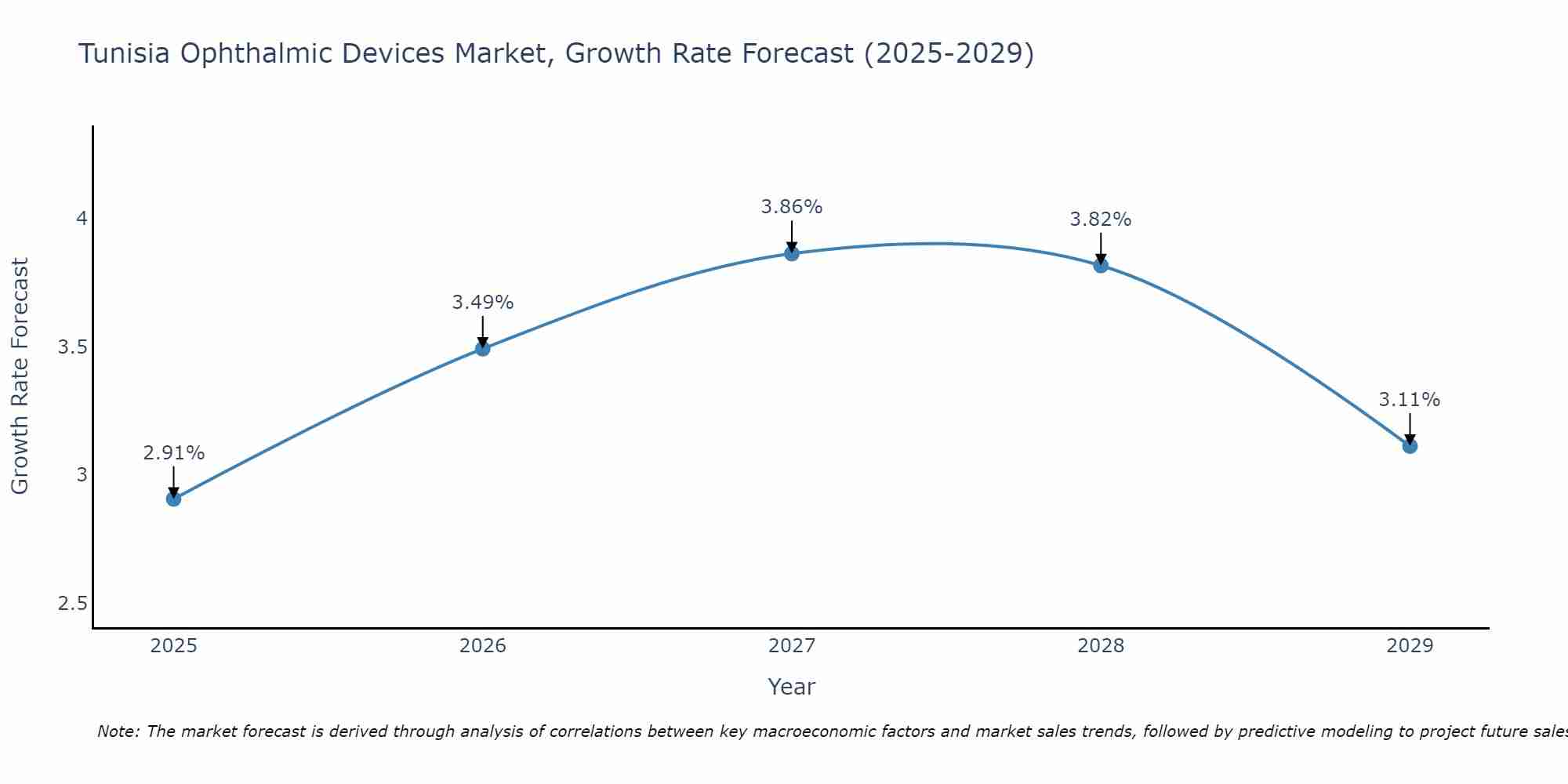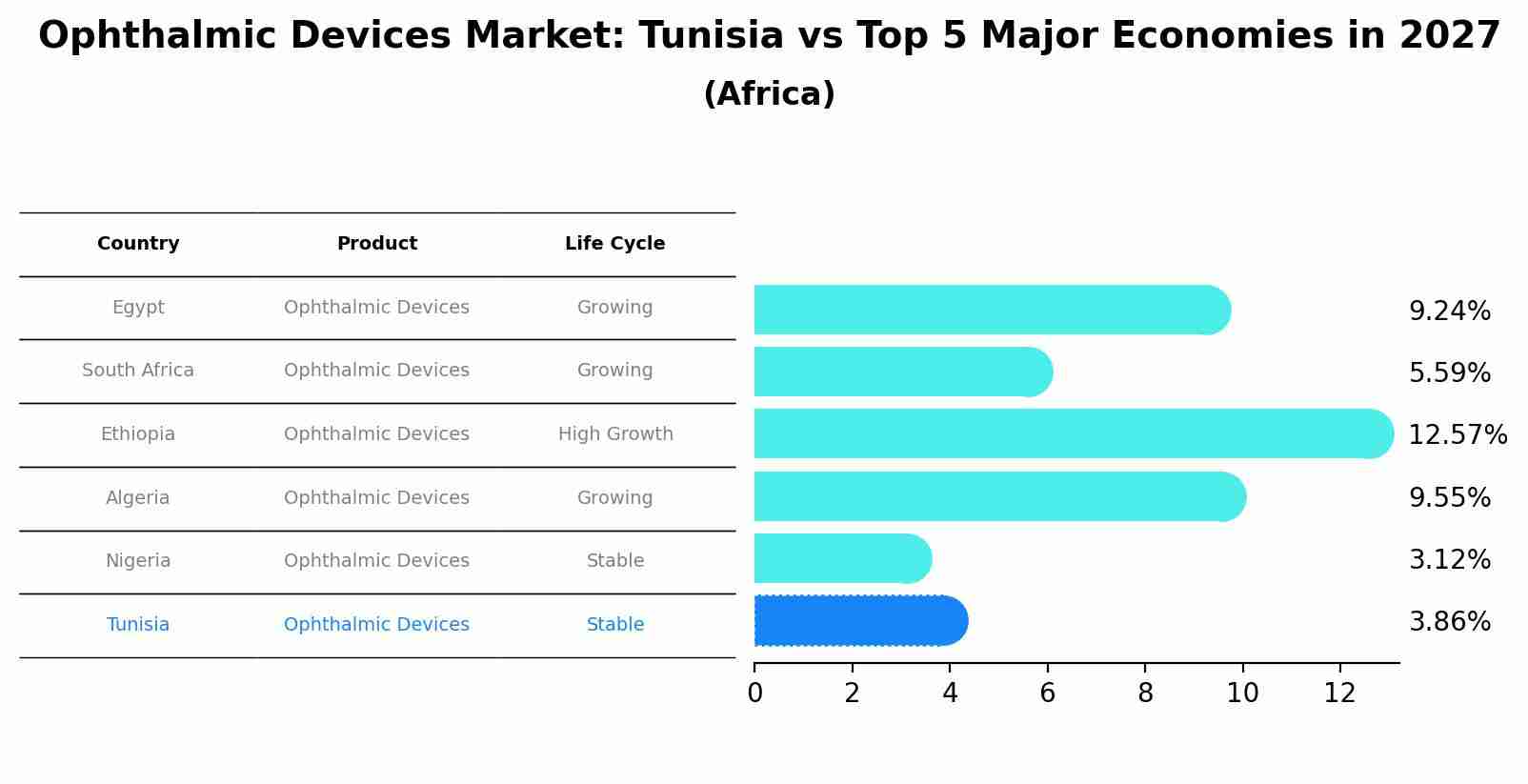Tunisia Ophthalmic Devices Market Outlook | Value, Size, Companies, Industry, Trends, Forecast, COVID-19 IMPACT, Share, Growth, Analysis & Revenue
| Product Code: ETC367914 | Publication Date: Aug 2022 | Updated Date: Jun 2025 | Product Type: Market Research Report | |
| Publisher: 6Wresearch | Author: Ravi Bhandari | No. of Pages: 75 | No. of Figures: 35 | No. of Tables: 20 |
Tunisia Ophthalmic Devices Market Size Growth Rate
The Tunisia Ophthalmic Devices Market is projected to witness mixed growth rate patterns during 2025 to 2029. Starting at 2.91% in 2025, the market peaks at 3.86% in 2027, and settles at 3.11% by 2029.

Ophthalmic Devices Market: Tunisia vs Top 5 Major Economies in 2027 (Africa)
Tunisia's Ophthalmic Devices market is anticipated to experience a stable growth rate of 3.86% by 2027, reflecting trends observed in the largest economy Egypt, followed by South Africa, Ethiopia, Algeria and Nigeria.

Tunisia Ophthalmic Devices Market Overview
The Tunisia Ophthalmic Devices Market is experiencing steady growth driven by factors such as an aging population, increasing prevalence of eye diseases, and advancements in healthcare infrastructure. The market is characterized by a wide range of products including diagnostic devices, surgical instruments, vision care products, and accessories. Key players in the market are focusing on innovative technologies to enhance diagnosis and treatment outcomes. Government initiatives to improve eye care services and increase access to ophthalmic devices are also contributing to market growth. However, challenges such as limited healthcare resources and affordability issues for certain patient segments may hinder market expansion. Overall, the Tunisia Ophthalmic Devices Market presents opportunities for both domestic and international companies to introduce new products and expand their presence in the region.
Tunisia Ophthalmic Devices Market Trends
One of the current trends in the Tunisia Ophthalmic Devices Market is the increasing adoption of advanced technology such as optical coherence tomography (OCT) and femtosecond lasers for precise diagnostics and treatments. This technology allows for more accurate and efficient procedures, driving demand for innovative ophthalmic devices in the market. Additionally, there is a growing focus on preventive eye care and early detection of eye diseases, leading to a rise in the demand for diagnostic devices like tonometers and fundus cameras. With the increasing prevalence of eye disorders and the aging population in Tunisia, there is a growing need for sophisticated ophthalmic devices to cater to the rising healthcare demands, indicating a positive outlook for the market`s growth in the coming years.
Tunisia Ophthalmic Devices Market Challenges
In the Tunisia Ophthalmic Devices Market, several challenges are prevalent. These include limited access to advanced technology and high-quality ophthalmic devices, which can hinder the ability of healthcare providers to offer optimal eye care services to patients. Additionally, there is a shortage of skilled ophthalmologists and other eye care professionals in the country, leading to a lack of expertise in diagnosing and treating eye conditions effectively. Moreover, the market faces regulatory hurdles and import restrictions that can slow down the introduction of new ophthalmic devices and technologies. Overall, addressing these challenges requires investment in training programs, infrastructure development, and regulatory reforms to improve the accessibility and quality of eye care services in Tunisia.
Tunisia Ophthalmic Devices Market Investment Opportunities
The Tunisia ophthalmic devices market presents several investment opportunities, driven by factors such as an increasing prevalence of eye diseases, a growing elderly population, and rising healthcare expenditure. Investments in advanced diagnostic equipment, such as optical coherence tomography (OCT) and fundus cameras, are promising due to the rising demand for early detection and monitoring of eye diseases like glaucoma and age-related macular degeneration. Additionally, opportunities exist in the development and distribution of intraocular lenses, contact lenses, and surgical instruments for cataract surgery and refractive procedures. Collaborations with local healthcare providers and the adoption of innovative technologies to enhance patient outcomes can further fuel growth in the Tunisia ophthalmic devices market, making it an attractive sector for investment.
Tunisia Ophthalmic Devices Market Government Policy
Government policies in Tunisia regarding the Ophthalmic Devices Market focus on ensuring safety, quality, and efficacy of medical devices. The Ministry of Health regulates the importation, distribution, and sale of ophthalmic devices through a registration process that requires compliance with set standards and regulations. Additionally, the government encourages domestic production of medical devices through incentives and support programs to enhance local manufacturing capabilities and reduce dependency on imports. The Ministry of Health also works to improve access to ophthalmic devices in underserved areas through public health programs and collaborations with international organizations to address eye health issues. Overall, the government`s policies aim to promote a competitive market while safeguarding public health and increasing access to quality ophthalmic devices in Tunisia.
Tunisia Ophthalmic Devices Market Future Outlook
The Tunisia Ophthalmic Devices Market is expected to witness steady growth in the coming years, driven by factors such as an aging population, increasing prevalence of ophthalmic disorders, and growing awareness about eye health. Technological advancements in ophthalmic devices, such as advanced diagnostic tools and minimally invasive surgical instruments, are also likely to contribute to market expansion. Additionally, the government`s initiatives to improve healthcare infrastructure and enhance access to eye care services will further propel market growth. However, challenges such as limited healthcare resources and economic constraints may hinder the market progress to some extent. Overall, the Tunisia Ophthalmic Devices Market is poised for growth opportunities, particularly in the segments of diagnostic devices, surgical instruments, and vision correction products.
Key Highlights of the Report:
- Tunisia Ophthalmic Devices Market Outlook
- Market Size of Tunisia Ophthalmic Devices Market, 2021
- Forecast of Tunisia Ophthalmic Devices Market, 2031
- Historical Data and Forecast of Tunisia Ophthalmic Devices Revenues & Volume for the Period 2018 - 2031
- Tunisia Ophthalmic Devices Market Trend Evolution
- Tunisia Ophthalmic Devices Market Drivers and Challenges
- Tunisia Ophthalmic Devices Price Trends
- Tunisia Ophthalmic Devices Porter's Five Forces
- Tunisia Ophthalmic Devices Industry Life Cycle
- Historical Data and Forecast of Tunisia Ophthalmic Devices Market Revenues & Volume By Product for the Period 2018 - 2031
- Historical Data and Forecast of Tunisia Ophthalmic Devices Market Revenues & Volume By Optical Coherence Tomography Scanners for the Period 2018 - 2031
- Historical Data and Forecast of Tunisia Ophthalmic Devices Market Revenues & Volume By Fundus Cameras for the Period 2018 - 2031
- Historical Data and Forecast of Tunisia Ophthalmic Devices Market Revenues & Volume By Perimeters/Visual Field Analyzers for the Period 2018 - 2031
- Historical Data and Forecast of Tunisia Ophthalmic Devices Market Revenues & Volume By Autorefractors and Keratometers for the Period 2018 - 2031
- Historical Data and Forecast of Tunisia Ophthalmic Devices Market Revenues & Volume By Ophthalmic Ultrasound Imaging Systems for the Period 2018 - 2031
- Historical Data and Forecast of Tunisia Ophthalmic Devices Market Revenues & Volume By Ophthalmic Pachymeters for the Period 2018 - 2031
- Historical Data and Forecast of Tunisia Ophthalmic Devices Market Revenues & Volume By Tonometers for the Period 2018 - 2031
- Historical Data and Forecast of Tunisia Optical Coherence Tomography Scanners Ophthalmic Devices Market Revenues & Volume By Slit Lamps for the Period 2018 - 2031
- Historical Data and Forecast of Tunisia Ophthalmic Devices Market Revenues & Volume By Application for the Period 2018 - 2031
- Historical Data and Forecast of Tunisia Ophthalmic Devices Market Revenues & Volume By Cataract for the Period 2018 - 2031
- Historical Data and Forecast of Tunisia Ophthalmic Devices Market Revenues & Volume By Vitreo retinal disorders for the Period 2018 - 2031
- Historical Data and Forecast of Tunisia Ophthalmic Devices Market Revenues & Volume By Glaucoma for the Period 2018 - 2031
- Historical Data and Forecast of Tunisia Ophthalmic Devices Market Revenues & Volume By Refractor Disorders for the Period 2018 - 2031
- Historical Data and Forecast of Tunisia Ophthalmic Devices Market Revenues & Volume By End-use for the Period 2018 - 2031
- Historical Data and Forecast of Tunisia Ophthalmic Devices Market Revenues & Volume By Hospitals and Eye Clinics for the Period 2018 - 2031
- Historical Data and Forecast of Tunisia Ophthalmic Devices Market Revenues & Volume By Academic and Research Laboratory for the Period 2018 - 2031
- Historical Data and Forecast of Tunisia Ophthalmic Devices Market Revenues & Volume By Others for the Period 2018 - 2031
- Tunisia Ophthalmic Devices Import Export Trade Statistics
- Market Opportunity Assessment By Product
- Market Opportunity Assessment By Application
- Market Opportunity Assessment By End-use
- Tunisia Ophthalmic Devices Top Companies Market Share
- Tunisia Ophthalmic Devices Competitive Benchmarking By Technical and Operational Parameters
- Tunisia Ophthalmic Devices Company Profiles
- Tunisia Ophthalmic Devices Key Strategic Recommendations
Frequently Asked Questions About the Market Study (FAQs):
- Single User License$ 1,995
- Department License$ 2,400
- Site License$ 3,120
- Global License$ 3,795
Search
Related Reports
- Portugal Occupational Health & Safety Services Market (2025-2031) | Strategy, Consumer Insights, Analysis, Investment Trends, Opportunities, Growth, Size, Share, Industry, Revenue, Segments, Value, Segmentation, Supply, Forecast, Restraints, Outlook, Competition, Drivers, Trends, Demand, Pricing Analysis, Competitive, Strategic Insights, Companies, Challenges
- Netherlands Occupational Health and Safety Services Market (2025-2031) | Strategy, Consumer Insights, Analysis, Investment Trends, Opportunities, Growth, Size, Share, Industry, Revenue, Segments, Value, Segmentation, Supply, Forecast, Restraints, Outlook, Competition, Drivers, Trends, Demand, Pricing Analysis, Competitive, Strategic Insights, Companies, Challenges
- Belgium and Luxembourg Facility Management Market (2025-2031) | Strategy, Consumer Insights, Analysis, Investment Trends, Opportunities, Growth, Size, Share, Industry, Revenue, Segments, Value, Segmentation, Supply, Forecast, Restraints, Outlook, Competition, Drivers, Trends, Demand, Pricing Analysis, Competitive, Strategic Insights, Companies, Challenges
- Russia Women Intimate Apparel Market (2025-2031) | Strategy, Consumer Insights, Analysis, Investment Trends, Opportunities, Growth, Size, Share, Industry, Revenue, Segments, Value, Segmentation, Supply, Forecast, Restraints, Outlook, Competition, Drivers, Trends, Demand, Pricing Analysis, Competitive, Strategic Insights, Companies, Challenges
- Africa Chocolate Market (2025-2031) | Size, Share, Trends, Growth, Revenue, Analysis, Forecast, industry & Outlook
- Global Hydroxychloroquine And Chloroquine Market (2025-2031) | Industry, Trends, Size, Outlook, Growth, Value, Companies, Revenue, Analysis, Share, Forecast
- Saudi Arabia Plant Maintenance Market (2025-2031) | Industry, Size, Growth, Revenue, Value, Companies, Forecast, Analysis, Share & Trends
- Taiwan Electric Truck Market (2025-2031) | Outlook, Industry, Revenue, Size, Forecast, Growth, Analysis, Share, Companies, Value & Trends
- South Korea Electric Bus Market (2025-2031) | Outlook, Industry, Companies, Analysis, Size, Revenue, Value, Forecast, Trends, Growth & Share
- Africa Low Temperature Powder Coating Market (2025-2031) | Companies, Competition, Size, Challenges, Segmentation, Trends, Competitive, Industry, Supply, Strategy, Investment Trends, Growth, Segments, Restraints, Strategic Insights, Revenue, Share, Forecast, Drivers, Analysis, Pricing Analysis, Demand, Consumer Insights, Value, Opportunities, Outlook
Industry Events and Analyst Meet
Our Clients
Whitepaper
- Middle East & Africa Commercial Security Market Click here to view more.
- Middle East & Africa Fire Safety Systems & Equipment Market Click here to view more.
- GCC Drone Market Click here to view more.
- Middle East Lighting Fixture Market Click here to view more.
- GCC Physical & Perimeter Security Market Click here to view more.
6WResearch In News
- Doha a strategic location for EV manufacturing hub: IPA Qatar
- Demand for luxury TVs surging in the GCC, says Samsung
- Empowering Growth: The Thriving Journey of Bangladesh’s Cable Industry
- Demand for luxury TVs surging in the GCC, says Samsung
- Video call with a traditional healer? Once unthinkable, it’s now common in South Africa
- Intelligent Buildings To Smooth GCC’s Path To Net Zero













